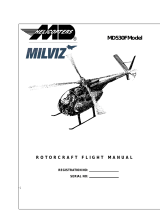190-01226-20 Rev. 2 RFMS, Garmin 400W Series GPS/SBAS System
Page 12 of 13
NOTE
Terrain Proximity and HTAWS are separate features. If “HTAWS”
is shown on the bottom right of the dedicated terrain page, then
HTAWS is installed.
HTAWS
The GNS 400W can include an optional Helicopter Terrain Awareness and
Warning System (HTAWS) which includes visual depictions of terrain and
obstacles relative to helicopter altitude as well as visual and aural alerts if terrain
or obstacles are a threat to the safe flight of the helicopter.
HTAWS is an alerting system. The system does NOT guarantee successful
recovery from a conflict due to factors such as pilot response, aircraft
performance, and database limitations. No standardized recovery technique is
defined as recovery maneuvers may vary. HTAWS protection is provided at
groundspeeds above 30 knots.
The Obstacle Database contains only KNOWN obstacles and does not contain
ALL existing obstacles. The Obstacle Database does not contain the location of
power line poles or wires.
HTAWS also includes pilot selectable Voice Callouts (VCOs) of helicopter
height above terrain from 500 feet AGL to the surface.
If HTAWS is not installed, then the GNS 400W will provide Terrain Proximity
functions which only provide visual depictions of terrain and obstacles on the
map page but provides no alerting or VCOs.
TERRAIN AND OBSTACLE DEPICTION
Terrain and obstacle elevations relative to aircraft altitude are depicted on the
Terrain page.
HTAWS NORMAL MODE
The GNS 400W will power on with HTAWS in Normal Mode. Normal Mode
provides for separation from terrain and obstacles appropriate for enroute, night,
and operations where the pilot is not in visual contact with terrain.
HTAWS REDUCED PROTECTION MODE
The “RP MODE” menu selection on the terrain page is used to activate the
Reduced Protection (RP) functionality. RP Mode reduces alerting thresholds
and suppresses aural and visual cautions to allow operation in closer proximity
to terrain and obstacles while continuing to provide protection from terrain and
obstacles. An optional “RP MODE” external switch installation on the
instrument panel or avionics console is allowed to toggle Reduced Protection
mode in the same manner as using the Terrain Menu selection.













